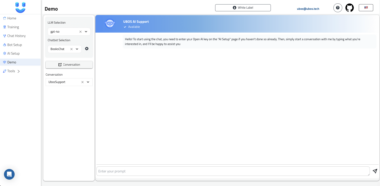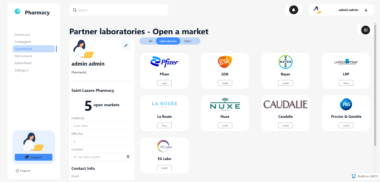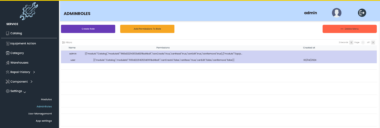forked https://github.com/modelcontextprotocol/servers/tree/main
Knowledge Graph Memory Server
A basic implementation of persistent memory using a local knowledge graph. This lets Claude remember information about the user across chats.
Core Concepts
Entities
Entities are the primary nodes in the knowledge graph. Each entity has:
- A unique name (identifier)
- An entity type (e.g., “person”, “organization”, “event”)
- A list of observations
Example:
{
"name": "John_Smith",
"entityType": "person",
"observations": ["Speaks fluent Spanish"]
}
Relations
Relations define directed connections between entities. They are always stored in active voice and describe how entities interact or relate to each other.
Example:
{
"from": "John_Smith",
"to": "Anthropic",
"relationType": "works_at"
}
Observations
Observations are discrete pieces of information about an entity. They are:
- Stored as strings
- Attached to specific entities
- Can be added or removed independently
- Should be atomic (one fact per observation)
Example:
{
"entityName": "John_Smith",
"observations": [
"Speaks fluent Spanish",
"Graduated in 2019",
"Prefers morning meetings"
]
}
API
Tools
create_entities
- Create multiple new entities in the knowledge graph
- Input:
entities(array of objects)- Each object contains:
name(string): Entity identifierentityType(string): Type classificationobservations(string[]): Associated observations
- Each object contains:
- Ignores entities with existing names
create_relations
- Create multiple new relations between entities
- Input:
relations(array of objects)- Each object contains:
from(string): Source entity nameto(string): Target entity namerelationType(string): Relationship type in active voice
- Each object contains:
- Skips duplicate relations
add_observations
- Add new observations to existing entities
- Input:
observations(array of objects)- Each object contains:
entityName(string): Target entitycontents(string[]): New observations to add
- Each object contains:
- Returns added observations per entity
- Fails if entity doesn’t exist
delete_entities
- Remove entities and their relations
- Input:
entityNames(string[]) - Cascading deletion of associated relations
- Silent operation if entity doesn’t exist
delete_observations
- Remove specific observations from entities
- Input:
deletions(array of objects)- Each object contains:
entityName(string): Target entityobservations(string[]): Observations to remove
- Each object contains:
- Silent operation if observation doesn’t exist
delete_relations
- Remove specific relations from the graph
- Input:
relations(array of objects)- Each object contains:
from(string): Source entity nameto(string): Target entity namerelationType(string): Relationship type
- Each object contains:
- Silent operation if relation doesn’t exist
read_graph
- Read the entire knowledge graph
- No input required
- Returns complete graph structure with all entities and relations
search_nodes
- Search for nodes based on one or more keywords
- Input:
query(string)- Space-separated keywords (e.g., “budget utility”)
- Multiple keywords are treated as OR conditions
- Searches across:
- Entity names
- Entity types
- Subdomains
- Observation content
- Matching behavior:
- Case-insensitive
- Partial word matching
- Any keyword can match any field
- Returns entities matching ANY of the keywords
- Returns matching entities and their relations
- Example queries:
- Single keyword: “budget”
- Multiple keywords: “budget utility”
- With special chars: “budget & utility”
open_nodes
- Retrieve specific nodes by name
- Input:
names(string[]) - Returns:
- Requested entities
- Relations between requested entities
- Silently skips non-existent nodes
Usage with Claude Desktop
Setup
Add this to your claude_desktop_config.json:
Docker
{
"mcpServers": {
"memory": {
"command": "docker",
"args": ["run", "-i", "--rm", "mcp/memory"]
}
}
}
NPX
{
"mcpServers": {
"memory": {
"command": "npx",
"args": [
"-y",
"@modelcontextprotocol/server-memory"
]
}
}
}
NPX with custom setting
The server can be configured using the following environment variables:
{
"mcpServers": {
"memory": {
"command": "npx",
"args": [
"-y",
"@modelcontextprotocol/server-memory"
],
"env": {
"MEMORY_FILE_PATH": "/path/to/custom/memory.json"
}
}
}
}
MEMORY_FILE_PATH: Path to the memory storage JSON file (default:memory.jsonin the server directory)
System Prompt
The prompt for utilizing memory depends on the use case. Changing the prompt will help the model determine the frequency and types of memories created.
Here is an example prompt for chat personalization. You could use this prompt in the “Custom Instructions” field of a Claude.ai Project.
Follow these steps for each interaction:
1. User Identification:
- You should assume that you are interacting with default_user
- If you have not identified default_user, proactively try to do so.
2. Memory Retrieval:
- Always begin your chat by saying only "Remembering..." and retrieve all relevant information from your knowledge graph
- Always refer to your knowledge graph as your "memory"
- When searching your memory, you can use multiple keywords to find related information
- Example searches:
* Single concept: "programming"
* Related concepts: "programming python"
* Specific domain with role: "work engineer"
3. Memory Creation:
- While conversing with the user, be attentive to any new information that falls into these categories:
a) Basic Identity (age, gender, location, job title, education level, etc.)
b) Behaviors (interests, habits, etc.)
c) Preferences (communication style, preferred language, etc.)
d) Goals (goals, targets, aspirations, etc.)
e) Relationships (personal and professional relationships up to 3 degrees of separation)
- When storing information, use specific and descriptive keywords that will help in future searches
4. Memory Update:
- If any new information was gathered during the interaction, update your memory as follows:
a) Create entities for recurring organizations, people, and significant events
b) Connect them to the current entities using relations
c) Store facts about them as observations
d) Use clear and searchable terms in entity names and observations to facilitate future retrieval
Building
Docker:
docker build -t mcp/memory -f src/memory/Dockerfile .
License
This MCP server is licensed under the MIT License. This means you are free to use, modify, and distribute the software, subject to the terms and conditions of the MIT License. For more details, please see the LICENSE file in the project repository.
Knowledge Graph Memory Server
Project Details
- yodakeisuke/mcp-memory-domain-knowledge
- @modelcontextprotocol/server-memory
- Last Updated: 3/25/2025
Recomended MCP Servers

MCP connects to the Kakao Local API and Kakao Map. 카카오 로컬 API 및 카카오맵에 연결하는 MCP 서버.

Runbook MCP Server

MCP server for aiding with literature reviews
A custom Model Context Protocol adapter for MediaWiki and WikiBase APIs
Model Control Protocol (MCP) server for YOURLS URL shortening integration with Claude Desktop
Use AI to edit image in Claude Desktop / Cursor (AI P图)

An intelligent MCP server that serves as a guardian of development knowledge, providing Cline assistants with curated access...
Ecovacs MCP Server

MCP Server for the Mapbox API.
 From vibe coding to vibe deployment. UBOS MCP turns ideas into infra with one message.
From vibe coding to vibe deployment. UBOS MCP turns ideas into infra with one message.






